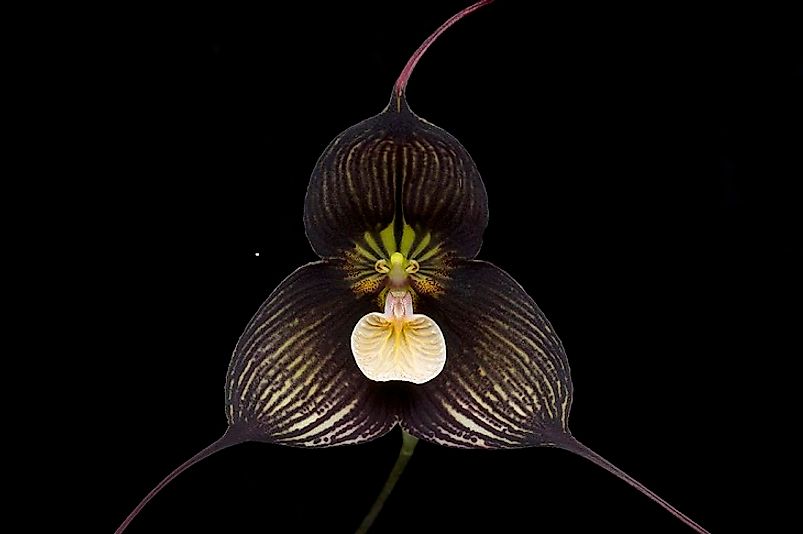Native Plants Of Ecuador

The country of Ecuador is located along the west coast of the northern regions of the South American continent. This country is home to many unique and even endemic plants, trees and orchids due to its diverse landscape that features the Amazon rain-forest, the Andean highlands and the Galapagos Islands that is located off the coast of the mainland. This article will cover a few of these native plants and discuss their physical characteristics, potential uses, habitats, ranges and their current conservation status, as well as the major threats that they face.
Ecuadorian Walnut
The Ecuadorian Walnut, scientific name Juglans neotropica, is a species of plant in the Juglandaceae Family of walnuts and closely related trees and shrubs. This species can grown to be up to 131 feet (40 meters) tall, although it is a slow-growing tree that can take a long time to reach this height. This species has red-brown colored bark that is grooved with a oval shaped canopy and compound leaves that are around 1.3 feet (40 centimeters) in length. The Ecuadorian Walnut produces edible fruits that turn yellow-green in color when ripe and are then harvested take out the Andean walnut, also known as a tocte nut, inside. The shell of the fruit can be used to made to produce yellow dye if unripe, red to brown dye if it is ripe or a strong black dye if ripe and cooked. The wood of this species, which is called nogal in South America, is highly valued in being used for various forms of decorations. This species is hard to find as it is spread out throughout the Andes mountains and the Andean valleys in Ecuador, Colombia and Peru. According to the International Union for the Conservation of Nature (IUCN) Red List the Ecuadorian Walnut has been listed as an endangered species since 1998. The major threats that this species faces are a decline in habitat, being over-logged for its timber and the lack of commercial plantations for the species to grow in regulated environments.
Guato
The Guato, scientific name Erythrina edulis, is a legume species of nitrogen-fixing trees, meaning they house organism in their roots which take nitrogen from the atmosphere and converts it into ammonia and release it into the surrounding soil, thereby enriching the ground. This species is a member of the Fabaceae Family of flowering plants. This species is robust and grows quickly, as it can grow to be anywhere between 26 to 46 feet (8 to 14 meters) tall. This species also produces unbranched red flowers that are pollinated by a variety of animals, like bees, birds and wasps. The Guato produces green colored pods that can be between 6 to 26 inches (15 to 65 centimeters) long and be 13 inches (32 centimeters) in diameter. These pods are edible, but the grains that grow on them, which are between 0.6 and 2.5 inches (1.4 and 6.4 centimeters) long and weigh 0.5 to 1.1 ounces (15 to 30 grams), are usually what is eaten after being cooked. These grains are extremely protein rich and are used in a variety of food from salads to cakes. The leaves, grains and pods from this plant are also good for feeding farm animals, fish and rabbits. This species can only grow in the tropics, but it is found at a range of different altitudes in the Andean region in Venezuela, Colombia, Ecuador, Peru, Bolivia and Argentina. The Guato has not yet been assessed by the ICUN Red List and the species appears to be under no major threats.
Little Dragon Orchid
The Little Dragon Orchid, scientific name Dracula vampira, is an orchid species that is epiphytic, meaning that it grows on other plants for physical support. It is part of the Orchidaceae Family of flowering plants, which is also known as the Orchid Family. This species has large, unique flowers as the sepal of the flower is large and rounded, being up to 4.33 inches (11 centimeters) and is green colored yet covered by vast black purple colored veins. The petals and lip of the flower is white, with slight purple and pinkish veins and is much smaller then the sepal. The leaves of this species grow to be around 5.9 to 11 inches (15 to 28 centimeters) long. This species is only found on the forested mountainside and slopes of the active stratospheric Mount Pichincha in Ecuador and is endemic to the country. The Little Dragon Orchid was listed as being vulnerable by the IUCN Red List, but that status has since been removed as the species is now fairly locally abundant in the location that it grows.
The Greater Significance of Ecuadorian Flora
There are many reasons why these native plants species are important, not only in Ecuador but in other countries around the world as well. Some of these native plant species are endemic, meaning that they are only found in that country and no where else in the world. Other native plant species are usefully as being a important and maybe unique source of food for that people in that country or region. Other native plant species are highly valuable for this timber or as natural habitats for various animal species to live in and call home.
Native Plants Of Ecuador
| Native Plants of Ecuador | Scientific Name |
|---|---|
| Chungay | Vasconcellea candicans |
| Prickly Ash Lime | Zanthoxylum fagara |
| Little Dragon Orchid | Dracula vampira |
| Wild Cashew | Anacardium excelsum |
| Young Palm Orchid | Tropidia polystachya |
| Guato | Erythrina edulis |
| Expansive Catasetum | Catasetum expansum |
| Ecuadorian Walnut | Juglans neotropica |
| Hollow Oncidium | Oncidium excavatum |
| Mocambo Tree | Theobroma bicolor |











